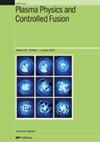准轴对称恒星器等离子体中密度剖面效应对平衡磁岛的抑制
IF 2.3
2区 物理与天体物理
Q2 PHYSICS, FLUIDS & PLASMAS
引用次数: 0
摘要
在准轴对称恒星器中,巨大的自举电流将导致低阶有理面和三维(3D)磁岛的产生。本文利用 HINT 代码研究了等离子体密度剖面对中国第一个准轴对称恒星器(CFQS)平衡磁岛的影响。研究发现,核心等离子体密度剖面的扁平化会显著抑制磁岛的产生。当等离子体密度的峰值因子为 1.19 时,磁岛被完全抑制,同时磁表面保持良好的完整性,即使等离子体的体积平均贝塔值增加到 2%。另一方面,在等离子体密度剖面从扁平向中空过渡期间,磁芯自举电流会发生逆转,导致通过合理表面的旋转变换值减少。因此,在磁芯区域形成了磁岛。因此,可以通过气体注入等方法适当控制密度剖面,从而有效抑制 CFQS 的磁岛。本文章由计算机程序翻译,如有差异,请以英文原文为准。
Suppression of equilibrium magnetic islands by density profile effect in quasi-axisymmetric stellarator plasmas
In a quasi-axisymmetric stellarator, a significant bootstrap current will result in the generation of low-order rational surfaces and three-dimensional (3D) magnetic islands. In this paper, the influence of plasma density profiles on the equilibrium magnetic islands for the Chinese first quasi-axisymmetric stellarator (CFQS) is investigated using the HINT code. It is found that the flattening of the core plasma density profile leads to a significant suppression of magnetic islands. When the peaking factor of plasma density is 1.19, complete suppression of magnetic islands occurs while maintaining excellent integrity of the magnetic surface even with the volume-averaged plasma beta <β > increase up to 2%. On the other hand, during the transition of a plasma density profile from flat to hollow, there is a reversal in the core bootstrap current, resulting in reduction of rotational transform values to pass through the rational surface. Hence, formation of magnetic islands in the core region. Therefore, effective inhibition of CFQS’s magnetic islands can be achieved by appropriately controlling density profiles through methods like gas injection.
求助全文
通过发布文献求助,成功后即可免费获取论文全文。
去求助
来源期刊

Plasma Physics and Controlled Fusion
物理-物理:核物理
CiteScore
4.50
自引率
13.60%
发文量
224
审稿时长
4.5 months
期刊介绍:
Plasma Physics and Controlled Fusion covers all aspects of the physics of hot, highly ionised plasmas. This includes results of current experimental and theoretical research on all aspects of the physics of high-temperature plasmas and of controlled nuclear fusion, including the basic phenomena in highly-ionised gases in the laboratory, in the ionosphere and in space, in magnetic-confinement and inertial-confinement fusion as well as related diagnostic methods.
Papers with a technological emphasis, for example in such topics as plasma control, fusion technology and diagnostics, are welcomed when the plasma physics is an integral part of the paper or when the technology is unique to plasma applications or new to the field of plasma physics. Papers on dusty plasma physics are welcome when there is a clear relevance to fusion.
 求助内容:
求助内容: 应助结果提醒方式:
应助结果提醒方式:


